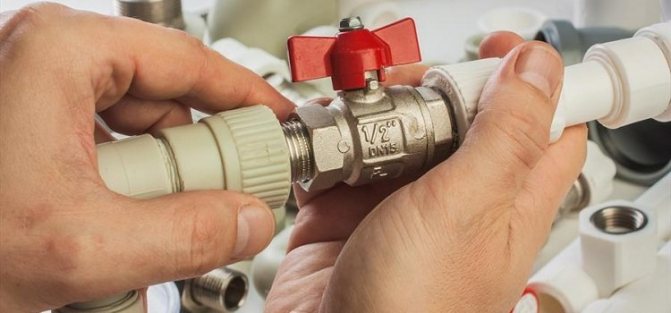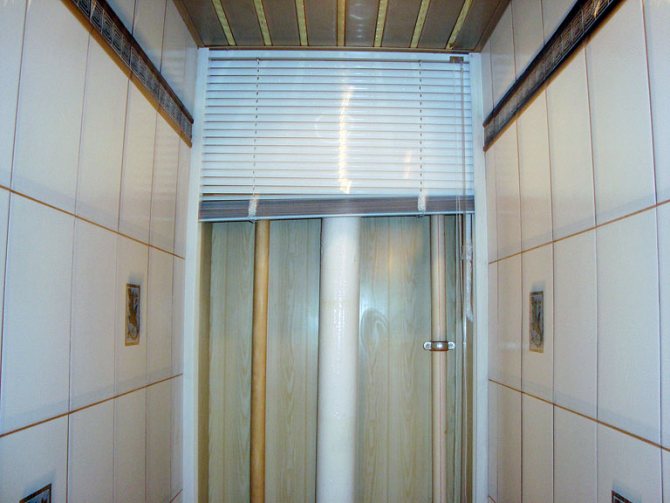Home/Water supply and sanitation/Replacement of risers in apartment buildings
Despite the fact that most residents are the owners of their apartments and pay for general building needs on a monthly basis, direct replacement of risers and other water supply elements is carried out by representatives of the management company (MC). Their actions are based on the regulatory framework of the laws of the Russian Federation. However, not many apartment owners know their rights if it is necessary to replace common communication elements located in their apartments.
The solution to replacing risers in an apartment building, the identification of responsible persons and the rules of behavior in conflict situations will be given below.
Attention! If you have any questions, you can chat for free with a lawyer at the bottom of the screen or call Moscow; Saint Petersburg; Free call for all of Russia.
Normative base
The regulatory framework for the replacement and repair of the water supply system is regulated by:
- rules for the maintenance of property located in the common possession of the apartment building (RF RF No. 491 dated 08/13/20016);
- standards for the technical use of housing stock (Resolution of the State Construction Committee of the Russian Federation dated September 27, 2003 No. 170);
- methodological manual for the operation, maintenance and repair of housing stock MKD 2-04.2004.
Responsibilities of the owner and management organization
The authority to maintain and repair any equipment located in an apartment building rests with both the owner of the living space and the management company to which the building belongs. Here everything depends on the installation location of the elements and devices necessary for the optimal functioning of the building and the apartments in it, as well as whether the equipment is common or personal property.
Responsibilities of the management organization
The service organization is obliged to carry out free replacement of equipment related to common property, since residents make a monthly contribution of funds for repairs and maintenance of it in good condition. According to the standards established by the MDK (Methodological manual for the maintenance and repair of housing stock), the list of works included in the rent contains:
- maintaining various common property in the appropriate order;
- maintenance of communication systems;
- emergency work;
- Maintenance.
In other words, any elements of communications used to ensure optimal functioning of the residents of the entire house are subject to repair at the expense of the management office. Moreover, some of them can be located within the apartment.
At the expense of the operating organization, the following equipment is repaired and replaced:
- gas supply pipes to the supply to the stove or heating appliances;
- water supply risers to the connection with the pipe distribution inside the apartment;
- heating risers up to the junction with discharge pipes;
- drainage system before connection with intra-apartment pipes;
- ventilation system;
- power supply system.
In fact, the owner of a privatized apartment pays in advance for the repair and maintenance of all life support systems in the house, paying a set amount specified in the monthly receipt. For this reason, employees do not have the right to demand any additional funds for replacing failed equipment.
Responsibilities of the owner of a privatized apartment
The owner of privatized real estate is obliged to carry out work to eliminate problems in devices and equipment located within the boundaries of his property. At the same time, there are a number of nuances regarding at whose expense the equipment will be replaced. It all depends on whether the device is part of the common property or is used only by the residents of the apartment.
Personal property for which troubleshooting is the responsibility of the property owner includes:
- gas and electric stoves;
- heating system, in particular, radiators and pipes leading to them;
- electrical equipment such as indoor cables;
- plumbing equipment;
- counters.
In the event of any malfunctions in the equipment related to the common building, the owner of the privatized apartment is obliged to promptly report the violations to the management company in order to eliminate them as quickly as possible. In another situation, one or another life support system may fail, which will negatively affect all residents of the apartment building and cause a lot of trouble for a particular owner. In such cases, the owner of faulty equipment often has to pay for the damage caused to other residents as a result of their own negligent attitude towards life support systems.
Who should change risers in an apartment building?
It is a mistake to believe that if the common water risers are used by the residents of the apartments of an apartment building, then the responsibility for replacing them rests entirely with them. Ignorance of the regulatory framework of the Housing Code leads to unnecessary waste of money from the pockets of owners.
Attention
Decree of the Russian Federation No. 354, Article 149 (dated May 6, 2011) and Article 161 of the Housing Code of the Russian Federation state that repairs, as well as complete replacement of risers in an apartment building, are the responsibility of the Management Company assigned to a specific building.
Every month, each apartment owner receives a receipt for utility bills, which contains the column “maintenance and repairs.” For those funds that come from residents from paying receipts, in particular for maintenance and repairs, all preventive and repair work must be carried out.
Consequently, in the event of a pipe break or other damage to the riser, the housing office is obliged to carry out repair work without charging residents (the reverse action is illegal).
Law Club Conference
.In our five-story building, a pipe burst in the ceiling, the neighbors below called a mechanic, he, in turn, decided to carry out repairs from our apartment, for which he received a verbal refusal, he was 100% provided with access to the pipes for inspection. Afterwards, a foreman from the housing and communal services came, to our question about why they don’t make repairs from the apartment below, we received the answer “WE DO NOT WORK LIKE THIS.” After some time, a neighbor came with the words “THE COMMISSION WILL CARRY OUT THE WORK FROM THE APARTMENT DOWNSTAIRS BUT WE WILL PAY”, BUT no one came to us, there was no commission at our house either.
We recommend reading: Is it possible to find out the boundaries of a plot by cadastral number?
Similarly, Part 1 of Article 36 of the Housing Code of the Russian Federation includes in the common property mechanical, electrical, sanitary and other equipment located in a given house outside or inside the premises and serving more than one room.
Replacement standards
According to the standards for replacing risers in an apartment building, they must be replaced in two cases:
- Expiration of the operational life of the metal structure.
- Complete renovation of the apartment's bathroom.
Living conditions provide for 2 modes of pipe replacement:
- planned - when the time for replacement has approached;
- emergency - when the integrity of the pipe has been damaged and a leak has formed.
IMPORTANT
The warranty period for pipes in apartment buildings is at least 25 years. Even if after this period the structure is intact without leaks, the riser still needs to be replaced.
Increasingly, cast iron pipes are being replaced with polypropylene ones. This is due to a number of advantages of the material:
- efficiency;
- ease;
- strength;
- environmental safety;
- resistance to deformation from thermal effects;
- resistance to corrosion and other influences;
- sliding structure of the internal walls, which prevents plaque formation;
- long service life: from 50 to 100 years.
What is included in replacing risers in an apartment building?
The process of replacing a riser in an apartment building is the direct removal of the old structure for a new one. However, this is not all that is included in the concept of “replacing a riser in an apartment building.”
Attention
First, you need to contact the management company and write an application to replace the pipe. The applicant will receive a satisfactory answer if the document is drawn up correctly and the facts supporting it do not raise doubts.
On the appointed day, representatives of the management company turn off the water in the risers and drain the remaining water. After this, craftsmen come from the management company or organization with which the management company has entered into an agreement. They carry out all the necessary procedures for replacing a faulty riser pipe in an apartment building.
- The master uses a grinder to cut out old pipes.
- Makes markings for new branches.
- New pipeline structures are being installed.
- They run water to check the tightness of all joints of the new riser.
By law, all necessary elements of the communication system that need to be replaced are delivered to the owner’s apartment. However, situations are not uncommon when the tenant himself, in whose apartment the installation is to be carried out, pays for all consumables and the element of the new pipe itself. By law, all expenses of the owner must be included in the payment of the receipt for the maintenance of common property for the next month.
Who is responsible for the hot water supply and hot water supply pipes laid in the floor screed?
Since the pipes from the common water risers located in our bathroom go further into the apartment (and they go in a concrete screed) with ball valves, they classify these pipes laid in the floor as common house property and accordingly refuse to replace them at their own expense, and they offer to do it for me.
We recommend reading: Sample Receipt for Receipt of Money for a Deposit for an Apartment
Recently, residents on the lower floor discovered a leak in the corner of the kitchen, the ceiling near the sewer pipe and the top of the wall were wet. We had a full inspection by a UK plumber and no leaks were found. Indeed, both in the kitchen and in the bathroom, in the risers and around them, it is absolutely dry! I checked everything myself.
Step-by-step instructions for replacing risers in an apartment building
A break in the water riser in one apartment requires its immediate replacement. Before carrying out repair work, the owner of an “emergency” apartment must discuss this action with the neighbors of the upper and lower floors. The fact is that the pipes are in a worn state along their entire length, despite the fact that the breakthrough occurred in a certain place. And for reliability, they should be replaced completely, in all apartments. If the neighbors disagree, the installation of a common water supply channel will be carried out only in one apartment.
The next step is to contact the Criminal Code. Their powers include shutting off the riser and draining the water. Next, complete or partial (in a separate apartment) installation of pipes takes place.
According to VSN 58-88 (r) “On the organization and implementation of reconstruction, repair and maintenance of buildings, public utility and social-cultural facilities,” planned replacement of water supply systems should be carried out every 25-30 years. Repair work is carried out inside privatized and non-privatized apartments, as well as in basements and entrances.
Replacing a sewer riser
The sewer riser belongs to the common property of the house, even though it passes through a private apartment (according to Article 290 of the Civil Code). Also, the RF PP No. 491 clause 5 dated 08/13/2006 states: “... the common property includes the drainage system, that is, the sewerage system...”.
Consequently, the management company is responsible for the installation and repair work of the sewer riser in an apartment building. For all the necessary consumables that will be required during the replacement process, as well as for the repair itself, apartment residents pay for it, paying monthly sums of money for receipts with the column “maintenance and repair of housing.”
IMPORTANT
On the day the sewer riser is replaced, the apartment owner does not have to pay anything.
But, if previously the owner of the apartment independently replaced the sewer pipe, and this fact is proven, then the owner is obliged to fully pay for the subsequent installation of this element of the communication system.
Before starting repairs to the sewer riser of an apartment building, a resident must:
- Visit the management company and leave an application for replacement of the emergency element.
- Draw up a report with a representative of the service organization, which will describe the condition of the sewer riser and (recommended) attach a photo.
- Specify the date and time of the work to be carried out, and notify neighbors about it in a timely manner.
- Determine the material of the structure that will be installed in place of the old one, as well as some nuances.
At the appointed time, repairmen come and carry out all the necessary actions to replace the sewer riser.
For your information
Upon completion, a “Certificate of Work Completed” is drawn up between the management company and the repair organization. The owner of the apartment should also keep a copy of this act.
How long can the water be turned off?
In Appendix No. 1 of the Government of the Russian Federation of May 6, 2011 N 354 (as amended on March 27, 2018) “On the provision of utility services to owners and users of premises in apartment buildings and residential buildings” there are deadlines for limiting water supply.
If there is a leak in the house, you can shut off the water supply for only 4 hours continuously and for 8 hours for the entire month
. If the deadlines are missed, you can apply for recalculation due to poor quality of service provided.
These standards will protect against management company employees who “fix” the problem by shutting off the water. As soon as the legal deadlines have passed, call the emergency dispatch service. Remind them that it is time to restore the water supply and fix the leak. Otherwise, recalculation or legal action.
Who pays to fix the leak?
All work and materials are paid for by the person causing the leak. It is determined by which part of the pipe is dripping from:
- Are water supply pipes leaking after the shut-off valve? The owner or tenant of the apartment is to blame for this.
- Are the pipes leaking to the shut-off valve? The management company is responsible.
- Is it leaking from the elbow, tank or toilet bowl? The owner is to blame.
- No leaking sewer visible, but water dripping? The management company is to blame.

A similar tap on the pipes in the apartment shares responsibility. Everything before it is repaired by the management company. After - the owner of the apartment
When the management company is responsible for repairs, it pays for almost everything:
- repair work;
- materials;
- destruction and subsequent repair of the ceiling and floor.
The management company must compensate for damage caused during the repair process.
. Exceptions are boxes covering communications. The owner, having limited access to the pipes, pays for the finishing, its dismantling and installation.
Please note that compensation must be considered on a case-by-case basis. Sometimes some of the damage leads to damage to a citizen’s property under Art. 1064 of the Civil Code of the Russian Federation. This practice exists in court cases. Then the compensation is greater.

Almost the only way to cover the pipes in the toilet and preserve the finish during emergency repairs. All other options - tiles or plastic panels - will have to be dismantled
If the leak occurs due to the fault of the owner, then he pays all repair costs.
Remember the inspection report. Neighbors from whom water flows definitely need this paper so as not to pay extra.
Payment for replacement
The answer to the question regarding payment for replacing a riser in an apartment building is contained in Government Decree of the Russian Federation No. 491 dated August 13, 2006. The document determines what is common property, who is responsible for its maintenance and accordingly pays for its repair and replacement.
According to PP No. 491 and its section “Rules for maintaining the property of an apartment building,” each apartment owner pays for the maintenance and repair of all communications in the building. The same information is contained in Article 158 of the Housing Code of the Russian Federation “Expenses of owners of premises in an apartment building”: all owners of apartments in apartment buildings are involved in the costs of maintaining and repairing common property.
Thus, all costs for replacing the water supply riser in an apartment building are paid by the housing and communal services from the funds that all apartment owners contribute monthly, depositing money for receipts for the maintenance of common property.
Who services the riser and how?
Repair work on common property (in particular, risers and taps on risers) must be carried out by the service organization free of charge, since the owners pay a monthly fee under the heading “maintenance and repair of residential premises,” which goes towards maintaining the common property.
An interesting question came to us from a reader who recently bought an apartment in a building managed by a housing cooperative. All 3 risers in the apartment have patches in the form of pieces of rubber held together with clamps, and there are traces of rust on the pipes. The reader’s question is the following: who should repair (replace) the risers (not completely, but only the worn part)?
What documents are issued to the property owner?

Upon completion of the installation of the MKD water riser pipe, a “Certificate of Work Completed” must be drawn up, which will state the following:
- date of drawing up the contract;
- serial number of the agreement according to which the act is issued;
- the volume of work performed and all actions taken;
- cost of work;
- name of the person performing the repair work;
- signatures of the contractor and the customer.
This document is made in 2 copies, one of which is given to the contractor, and the second remains with the customer. The contractor is the organization that replaces the damaged element. The customer can be the management company (in which case one copy remains with them and is not given to the owner of the apartment) or directly the owner of the property.
Even if the agreement was drawn up by a representative of the management company and the repair company, the apartment owner should make himself a copy of this act.
Is it possible to refuse to replace risers in an apartment building?
“Is it possible to refuse to replace the riser?” - a pressing question for those residents who have undergone a major renovation of the apartment, because the proposed general house procedure implies some damage to the owner’s property in the bathroom. Is it possible to write a refusal?
Based on the information contained in clause 5 of PP No. 491, risers in apartment buildings are common property. According to the law, none of the residents has the right to prevent representatives of the contractor (MC), as well as emergency services, State control and supervision authorities from inspecting the current condition of communication equipment and carrying out repair work. A control inspection should be carried out no more than once every 90 days, and in case of an emergency - at any time.
Thus, apartment owners do not have the opportunity to refuse to replace common communication systems in an apartment building. In response to the refusal, the management company or HOA has the right to sue.
Possible conflicts and their resolution

- Refusal of the management company to replace faulty equipment.
- Neighbors disagree with replacing the riser in an apartment building.
There is no point in delaying their decision, especially if replacement of the emergency element is required in the very near future.
When contacting the management company with an application to replace the riser in an apartment building, you may encounter a refusal to carry out the work. The reasons may be different, but most often the management organization refers to the serviceability of the communication system. In this case, the owner has every right to sue the management company, as well as to recover monetary compensation from them for the damage caused.
A common emergency pipeline often leaks not only in one apartment, but also in neighbors above or below. Or the riser is in unusable condition and requires a total replacement, and not just a separate “fragment”. Therefore, installation should be carried out in several apartments. But there are often cases when some of the owners refuse to carry out the necessary work.
It is possible to solve the problem through conversations, but they do not always lead to the desired result. In this situation, the best solution would be a trial. But it is not other apartment owners who must apply to the court, but the management company. In his application to the judicial authorities, the representative of the management company puts forward a demand to the court to force the owner to replace the riser.
For your information
Litigation is not a quick process, but it is effective. According to his decision, the owner obstructing the repair undertakes not only to allow repairmen to replace the pipe, but also to install the concealing box (if there is one). The judge can significantly speed up the process of the case by satisfying the plaintiff’s request in accordance with Art. 212 of the Civil Procedure Code.
Consultation with a lawyer on issues of riser in an apartment
I was flooded by my upstairs neighbors, in the area of the kitchen riser (cold water supply). I made an application to the city housing department, a locksmith came and the neighbor refused access to communications, citing the fact that she had them closed with a box, and she would not open or break anything. The next day the day a foreman from the GZhU came, he was also not allowed to access communications. Without having access to communications, the GZHU issued an order, which was brought to her by a mechanic, to which the neighbor replied that she would not receive or sign any order. As a result, after 2-3 days, the walls in the apartment and the ceiling, as well as the wall on the entrance side (the boundary between the floors), began to dry out. My apartment was damaged, and the management company was unable to find out the reason. Explain my further actions.
In our entrance it is planned to replace the sewer and water risers. There is no emergency situation, but the initiator, the eldest in the entrance, is going to make repairs in her apartment (at the same time). My neighbors on the floors and I agree. The “specialist” from the management company demands that I disassemble half of the bathroom, dismantle the sink and bathtub. I did not make unauthorized alterations, but decent repairs were done. A compromise solution has not been reached. I believe there is an alternative to devastation; he wants to work quickly and simply (I suggest paying him “for the inconvenience”). Result: The management company declared me a saboteur, the senior woman at the entrance intimidated me that they would “cut off” my apartment. Questions: What are my rights and responsibilities in a specific situation? 2. Should the management company take into account the interests of the owners during repairs? 3. If I do not agree with the “barbaric conditions,” do they have the right to “cut off” my apartment from the general system? Thank you in advance.
Complaint about poor quality replacement of risers in an apartment building
If the emergency riser is replaced poorly, the apartment owner has the right to file a complaint against the organization responsible for this matter. The complaint is submitted in writing to the State Housing Inspectorate of a specific region of Russia. It indicates the name and address of the owner where the emergency water riser is located.
The complaint consists of a statement and a request. The application must refer to Art. 161 of the Housing Code of the Russian Federation “General requirements for the management of an apartment building” and indicate that the repair work did not eliminate the emergency situation. The petition contains the applicant’s request to oblige the management company to correct the problems in accordance with the standards.
It would not be amiss to attach to the complaint photographic materials proving poor quality work, as well as an act drawn up between the tenant and the management company.









